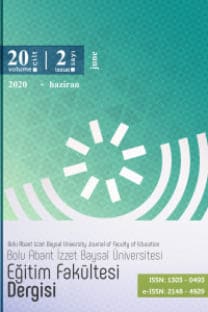Yapılandırmacı Öğrenme Yaklaşımına Dayalı Matematik Öğreniminin Bilimi Tanıma,Yaşam İle İlişki Kurma,Öğrenmeyi Öğrenme,Sorgulayarak Ve İletişim Kurarak Öğrenme Üzerindeki Etkisinin Belirlenmesi
Bu çalýþmanýn amacý, yapýlandýrmacý öðrenme yaklaþýmýna dayalý matematik öðreniminin, öðrencilerin bilimi tanýma, yaþam ile okulu iliþkilendirme, öðrenmeyi öðrenme, sorgulayarak öðrenme ve iletiþim kurarak öðrenme yönündeki yaklaþýmlarýna olan etkisini belirlemektir. Araþtýrma kontrol gruplu ön test-son test modeline dayalý yarý-deneysel bir çalýþmadýr. Deney ve kontrol gruplarý 2005–2006 öðretim yýlý Analiz-I dersini alan öðrenciler arasýndan yansýz olarak seçilmiþtir. Deney grubunda 31, kontrol grubunda ise 29 denek bulunmaktadýr. Araþtýrmada nicel ve nitel veri toplama araçlarý kullanýlmýþtýr. Nicel veriler, iki gruba çalýþmanýn hem baþýnda hem de sonunda uygulanan, “Yapýlandýrmacý Öðrenme Ortamlarýnýn Belirlenmesi Ölçeði(YÖOBÖ)” adlý bilimi tanýma (BT),okul ile yaþamý iliþkilendirme (OYÝ), öðrenmeyi öðrenme (ÖÖ), sorgulayarak öðrenme (SÖ) ve iletiþim kurarak öðrenme (ÝKÖ) alt gruplarý içeren 5’li Likert tipi ölçek ile derlenmiþtir. Nitel veriler ise deney grubu deneklerinden seçilen 10 denek ile yapýlan yarý-yapýlandýrýlmýþ görüþmeler ile süreç boyunca deney grubu deneklerinden toplanan günlüklerinden elde edilmiþtir. Analiz sonuçlarý, yapýlandýrmacý öðrenme yaklaþýmýna dayalý matematik öðreniminin yaþam ile okulu iliþkilendirme, öðrenmeyi ve iletiþim kurarak öðrenmede geleneksel öðrenme yaklaþýmýna göre daha etkili olduðunu göstermiþtir. Buna karþýlýk, bilimi tanýma ve sorgulayarak öðrenmede deney ve kontrol grubu arasýnda istatistiksel olarak anlamlý bir fark bulunmamýþtýr. Günlük ve görüþmelerin analizi ise deney grubu öðrenme ortamýnýn sýralanan alanlarda deneklere önemli katkýlar saðladýðýný göstermiþtir
Anahtar Kelimeler:
Matematik öðrenimi, Yapýlandýrmacý öðrenme yaklaþýmý, Yapýlandýrmacý öðrenme ortamlarý
THE EFFECT OF A CONSTRUCTIVIST APPROACH TO MATHEMATICS LEARNING ON DEFINING SCIENCE, CONNECTING LIFE AND SCHOOL, LEARNING TO LEARN, LEARNING TO SPEAK OUT AND LEARNING TO COMMUNICATE
The purpose of the study is to determine the effect of constructivist mathematics learning on students’ approaches to defining science, connecting life and school, learning to learn, learning to speak out, and learning to communicate. The study is a quasi-experimental research conducted with 60 first-year student mathematics teachers taking the Calculus course. The experimental group consists of 31 students, and control group consists of 29 students. Both quantitative and the qualitative methods were used. The quantitative data were collected by using “The Determining Constructivist Learning Environment Questionnaire”, a 5-point Likert type scale used at the beginning and at the end of the study. It consists of five sub-groups named defining science, connecting life and school, learning to learn, learning to speak out, and learning to communicate. The qualitative data were collected by using a semi-structural interview and students’ diaries. The analyzing of the data indicated that the constructivist mathematics learning approach was more effective than the traditional mathematics learning approach in connecting life and school, learning to learn, and learning to communicate. On the other hand, there were no statistical differences between the experimental and the control group in defining science and learning to speak out. The analysis of the diary and interview data also showed that constructivist mathematics learning contributed to the students’ approaches listed above
Keywords:
Constructivist learning approach, Mathematics learning, Constructivist learning environment,
___
- Aldridge J. M., Fraser B. J., Taylar P. C., Chen C.C. (2000). Constructivist Learning Environments in a Cross-National Study in Taiwan and Australia. International Journal of Science Education. 22(1), 37-55. 2002.
- Brooks, J.G., & Brooks, M.G. (1993). The Case for Constructivist Classrooms. Alexandria, VA.: Association for Supervision and Curriculum Development.
- Bukova Güzel, E., Alkan, H. (2005). Yeniden Yapýlandýrýlan Ýlköðretim Programý Pilot Uygulamasýnýn Deðerlendirilmesi. Kuram ve Uygulamada Eðitim Bilimleri Dergisi. 5(2), (Kasým, 2005).
- Dryden, M., Fraser B. J. (1998, aPRÝL). The Impact of Systemic Reform Efforts in Promoting Constructivist Approaches in High School Science. The Annual meeting of the American Educational Research Association, San Diego CA, USA.
- Eggen, P. and Kauchak, D. (1997). Educational Psychology: Windows on Classrooms. Upper Saddle River, NJ: Merrill.
- Ernst, P. (1995). The one and the many. In L. Steffe & J. Gale (Eds.). Constructivism in education (pp. 459-486). New Jersey: Lawrence Erlbaum Associates.
- Fox, R. (2001). Constructivism Examined. Oxford Review of Education. 27 (1). 23-35. (2001).
- Garfield, J. and Ahlgren, A. (1988). Difficulties in Learning Basic Concepts in Probability and Statistics: Implications for Research. Journal for Research in Mathematics Education. 19, 1, 44– 63.
- Hatano, G. (1996). A conception of knowledge acquisition and its implications for mathematics education. In L. W. Steffe & P. Nesher (Eds.), Theories of mathematical learning (pp. 187-217). Mahwah, NJ: Lawrence Erlbaum Associates.
- Honebein, J. (1996). Seven Goals for the Design of Constructivist Learning. http://cter.ed.uiuc.edu/JimL_Courses/edpsy490i/su01/readings/honebein.htm (14.01 2006)
- Mazosh, S. (2002). Constructivism. http://www.swt.edu/~sm58005/constructivism%20rp. html. (22.12.2002)
- Murphy, E., S. (1997). Characteristics of Constructivist Learning&Teaching. http://www.cdli.ca/~elmurphy/emurphy/cle3.html, (10.06.2004).
- Pevoto, C. (1997). Constructivist design principles. http://gamma.is.tcu.edu/~ cpevoto/treatise/design.htm, (10.10.2004).
- Þaþan, H. (2002). Yapýlandýrmacý öðrenme. Yaþadýkça Eðitim. 74-75. 49-52. 2002.
- ISSN: 1303-0493
- Yayın Aralığı: Yılda 4 Sayı
- Başlangıç: 2000
- Yayıncı: Abant İzzet Baysal Üniversitesi Eğitim Fakültesi
Sayıdaki Diğer Makaleler
Faculty of Education Students' Attitudes Toward Internet and Implications for Online Learning
İlköğretim 2. Kademe Öğrencilerinin Öğrenme Stillerinin Demografik Özellikleriyle İlişkisi
İlknur PALAS AKTAŞ, Dilşad MİRZEOĞLU, - -
Okuma Ve Yazma Çalışmalarında Şiir Etkinliklerinden Nasıl Yararlanılabilir?
Aday Öğretmenlerin Eleştirel Düşünme Eğilimleri İle Duygusal Zeka Düzeyleri Arasındaki İlişki
Gülseren DUTOĞLU, Meriç TUNCEL
Öğretmenden Öğrenciye Yönelik Olan Fiziksel Şiddet: Nicel Bir Araştırma
Okulu Bırakmanın Önlenmesi Ve Önlemeye Yönelik Uygulamalar
Hakan ÖZAK, Murat VURAL, Hasan AVCIOĞLU
Hakan ÖZAK, Murat VURAL, Hasan AVCIOĞLU
İlköğretim Okulu Öğretmenlerinin Örgütsel Değerlere İlişkin Görüşleri
